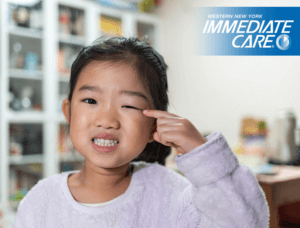
Can I Get Pink Eye
From My Child?
By: Deepa Ravi, MD, FAAP
What is pink eye?
Pink eye, also called conjunctivitis, is an inflammation that includes reddening or swelling of the thin tissue covering the white part of the eye as well as the inside of the eyelids, specifically the lower lid.
You can catch pink eye as an adult. It is spread the same ways as other viral and bacterial infections, such as the common cold. Children with pink eye should be kept home from school or daycare until they are no longer contagious. With proper precautions, like washing your hands thoroughly and frequently, adults can return to work or other places outside the home.
What causes pink eye?
There are several causes and related symptoms of pink eye:
- Bacterial
- Red or pink, itchy, painful eye(s)
- More than a tiny amount of green or yellow discharge
- Infected eyes may be crusted shut in the morning
- May affect one or both eyes
- Viral
- Pink, swollen, watering eye(s) that are sensitive to light
- May affect only one eye
- At times may have tearing that is clear or with scant yellow discharge
- Allergic
- Itching, redness, and excessive tearing, usually of both eyes
- Chemical
- Red, watery eyes, especially after known exposure to spray, pool chemicals, fumes, etc.
- Immune mediated
- Related to a systemic disease like MIS-C or Kawasaki’s Disease
How long does pink eye last?
The incubation period for pink eye – the time between being exposed to the disease and when symptoms start – can vary depending on the type of pinkeye.
- Bacterial: the incubation period is generally 2-4 days after exposure and the period when you would not be considered contagious is after 48 hours of starting medication or when symptoms are no longer present.
- Viral: conjunctivitis can sometimes occur early in the course of a viral upper respiratory infection with symptoms such as runny nose and cough with sore throat. Antibiotics for this condition do not help the patient or reduce the spread. The contagious period continues while the signs or symptoms are present.
- Allergic: there is no incubation period, and the onset is generally an immediate reaction to a trigger that may be delayed many hours or days after contact. This type of conjunctivitis is not considered contagious.
- Chemical conjunctivitis usually appears shortly after contact with the irritating substance such as noxious fumes, or pool chemicals. This also does not have a contagious period.
How is pink eye spread?
Conjunctivitis is usually spread when hands become contaminated by direct contact with discharge from an infected eye, or by touching other surfaces that have been contaminated by respiratory tract secretions and getting into the eyes.
What should I do if I suspect myself or my child may have pink eye?
- Consult a health professional for diagnosis and possible treatment, although the role of antibiotics in preventing spread or shortening the clinical course is unclear.
- Use careful hand washing before and after touching the eyes, nose, and mouth.
- Clean objects that are commonly touched by hands or faces, such as tables, doorknobs, phones, cots, cuddle blankets and toys.
How can I prevent pink eye?
The best method for preventing the spread of pink eye—and for staying healthy in general—is proper hand hygiene!
If someone in your family has symptoms of pink eye and needs to be seen by a provider, we accept walk-in patients every day of the week. Find our locations and hours.
